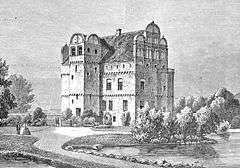Hesselagergård
| Hesselagergård | |
|---|---|
 | |
| General information | |
| Architectural style | Renaissance |
| Town or city | Funen |
| Country | Denmark |
| Construction started | 1538 |
| Completed | 1550 |
| Client | Johan Friis |
| Technical details | |
| Structural system | Masonry on granite plinth |
| Design and construction | |
| Architect | Martin Bussert and others |
Hesselagergård Manor, located near Gudme in the southeast of the Danish island Funen, is the oldest Renaissance building in Denmark. It was built by Johan Friis, one of the most powerful men in Denmark during the reigns of Christian III and Frederick II.
History
It is first documented in the 13th century, when it was mentioned in Valdemar II's Liber Census Daniæ as Crown land. In 1419, it belonged to the Bild family.[1]
From 1538-50 it was rebuilt in Renaissance style by Johan Friis. Construction of the main building began in 1538, probably under the direction of Martin Bussert. It was a late-gothic stone house in two stories with a tower in the northeastern corner. In 1548 an extra storey and two more towers were added, probably by Jacob Binck. In 1550 the building was given its characteristic roof. The estate remained in the Friis family until 1682.[2]
In June 1850 Hans Christian Andersen Visits the Hesselagergård Estate. In his diary he describes how he felt ill at ease when he saw the portraits of the Duke of Augustenborg and the Prince of Nør "plastered on the walls of the lavatory" (the diary, 22 June).[3]
From 1904 the estate has been owned by the Blixen-Finecke family.
Architecture
The construction started as a late gothic defensive castle, built of large red brick on a granite plinth and surrounded by a moat, but by the end it had introduced many renaissance features. Especially noteworthy are the highly decorated hipped, round gables inspired by Venitean renaissance church architecture. They are among the earliest known examples of this kind in Northern Europe. Not until the following decades are they seen in townhouses of Northern France and Austrian castles, sich as Schwerin and Gadebusch (15880-83).[4]
Also typical of the time are the blank arches below the projecting masonry and the watchman's passage at the top with machicolation for missiles and boiling liquid (as, for example, on Johan Friis' manor house Borreby on Sjælland). Other notable features are the decorative tops to the towers and depressed round-arched windows.[5]
Internally Hesselagergård is famous for its frieze in the Deer Room. It depicts large deer, landscapes, towns and people and was probably executed by Jacob Brinck around 1550.[6]
References
- ↑ "Hesselagergård". Gyldendal. Retrieved 2009-12-23.
- ↑ "Hesselagergård". Gyldendal. Retrieved 2009-12-23.
- ↑ "Hans Christian Andersen Homes and Manor Houses". Astoft. Retrieved 2009-12-23.
- ↑ "Hesselagergård". Gyldendal. Retrieved 2009-12-23.
- ↑ "Manor Houses on Fyn and Tåsinge, Denmark". Astoft. Retrieved 2009-12-23.
- ↑ "Hesselagergård". Dansk Arkitektur Center. Retrieved 2009-12-23.
| ||||||||||||||||||||||||||||||
| ||||||||||||||||||||||||||||||
Coordinates: 55°09′26″N 10°45′46″E / 55.15722°N 10.76278°E